Evolution of technologies for fracturing geologic formations to increase oil and natural gas production.
Ever since the earliest U.S. oil discoveries, detonating dynamite or nitroglycerin downhole helped increase a well’s production. The geologic “fracking” technology commonly used in oilfields after the Civil War would be significantly enhanced when hydraulic fracturing arrived in 1949.
Modern hydraulic fracturing — popularly known as petroleum well “fracking” — can trace its roots to April 1865, when Civil War Union veteran Lt. Col. Edward A. L. Roberts received the first of his many patents for an “exploding torpedo.”
In May 1990, Pennsylvania’s Otto Cupler Torpedo Company “shot” its last oil well with liquid nitroglycerin as the company abandoned using nitro while continuing to pursue a fundamental oilfield technology. Company President Rick Tallini credited Col. Roberts’ original patents for leading to the modern fracturing systems.

In 1862, E.A.L. Roberts was appointed Lieutenant Colonel of the Union Army. In December he “conceived the idea of opening the veins and crevices in oil-bearing rock by exploding an elongated shell or torpedo therein.” Images courtesy Drake Well Museum, Early Days of Oil, Princeton University Press.
When the Roberts patent expired in 1883, his company was sold to former employee Adam Cupler Jr. — who died in a 1903 nitro explosion. The Cupler Torpedo Company became Otto Cupler Torpedo Company in 1937 after Otto Torpedo Company purchased it.
“Our business since Colonel Roberts’ day has concerned lowering high explosives charges into oil wells in the Appalachian area to blast fractures into the oil bearing sand,” Tallini said.
Col. Roberts’ torpedo company operated in the Allegheny region of Titusville, where the U.S. petroleum industry began in August 1859 with the first American well specifically drilled for oil.
The Civil War veteran’s explosive method for fracking wells in oil-bearing geologic formations would be adopted throughout the Pennsylvania oil regions (sometimes illegally), and in other states making their first oil discoveries.
Civil War Veteran’s Torpedo Company
Civil War veteran Col. Edward A.L. Roberts led a New Jersey Regiment at the bloody 1862 Battle of Fredericksburg, Virginia. Amid the chaos of the battle, he saw the results of explosive Confederate artillery rounds plunging into the narrow millrace (canal) that obstructed the battlefield.
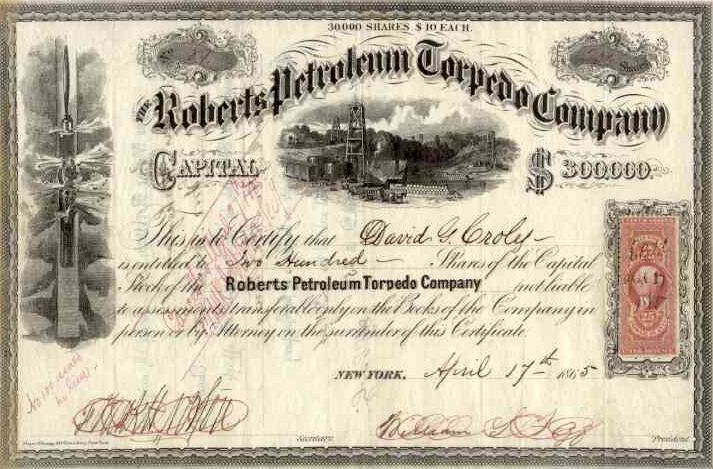
When E.A.L. Roberts founds his company in 1865, his many patents give him a monopoly on torpedoes needed by the oil industry.
Despite heroic actions during the battle, he was cashiered from Union Army in 1863. But the Virginia battlefield observation gave him an idea that would evolve into what he described as “superincumbent fluid tamping.”
Roberts received his first patent for an “Improvement in Exploding Torpedoes in Artesian Wells” on April 25, 1865. His oilfield invention of fracturing to improve a well would vastly improve oil production from America’s young petroleum industry. Many more of the technology patents would follow.
The Roberts torpedo system eclipsed earlier oilfield methods, including black powder or dropping sticks of dynamite down a well, which often collapsed boreholes and ruined production.
The same month Roberts was awarded his first exploding torpedo patent, an actor with a failed Pennsylvania oil well assassinated President Lincoln. In June 1864, John Wilkes Booth left Pennsylvania’s oilfields after a botched fracturing attempt at an oil well drilled by his Dramatic Oil Company.
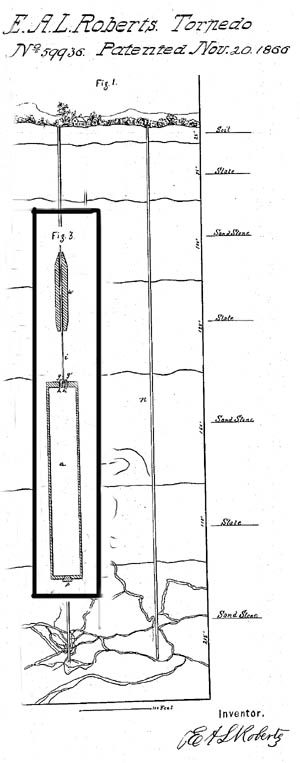
Tamped with water, early torpedoes were set off by “Go Devils,” a weight dropped along a suspension wire.
Roberts received another U.S. Patent (No. 59,936) in November 1866. This improved device would become widely known as the Roberts Torpedo.
By filling the borehole with water before detonating his torpedo, Roberts greatly advanced the U.S. oil industry’s production technology. The column of water above the explosive device more effectively shattered rock formations at the oil-producing depths of wells.
“Shooting” Oil Wells
The Titusville Morning Herald newspaper reported: Our attention has been called to a series of experiments that have been made in the wells of various localities by Col. Roberts, with his newly patented torpedo. The results have in many cases been astonishing.
The torpedo, which is an iron case, containing an amount of powder varying from fifteen to twenty pounds, is lowered into the well, down to the spot, as near as can be ascertained, where it is necessary to explode it. It is then exploded by means of a cap on the torpedo, connected with the top of the shell by a wire.
Filling the borehole with water provided Roberts his “fluid tamping” to concentrate concussion and more efficiently fracture surrounding oil strata.
The downhole technique had an immediate impact — production from some wells increased 1,200 percent within a week of being shot – and the Roberts Petroleum Torpedo Company flourished.
Roberts charged $100 to $200 per torpedo and a royalty of one-fifteenth of the increased flow of oil. Attempting to avoid Roberts’ fees, some oilmen hired unlicensed practitioners who operated by “moonlight” with their own devices. The inventor was outraged.
Roberts hired Pinkerton detectives and lawyers to protect his patent — and is said to have been responsible for more civil litigation in defense of a patent than anyone in U. S. history. He spent more than $250,000 to stop the unlawful “torpedoists” or “moonlighters.”

Pouring nitro into a canister to prepare a “shooting” of a well drilled using a cable-tool rig powered with a nearby steam boiler.
Applied legally or illegally, by 1868 nitroglycerin was preferred to black powder, despite its frequently fatal tendency to detonate accidentally.
“A flame or a spark would not explode Nitro-Glycerin readily, but the chap who struck it a hard rap might as well avoid trouble among his heirs by having had his will written and a cigar-box ordered to hold such fragments as his weeping relatives could pick from the surrounding district,” noted John J. McLauren in 1896 in his book Sketches in Crude Oil — Some Accidents and Incidents of the Petroleum Development in all parts of the Globe.
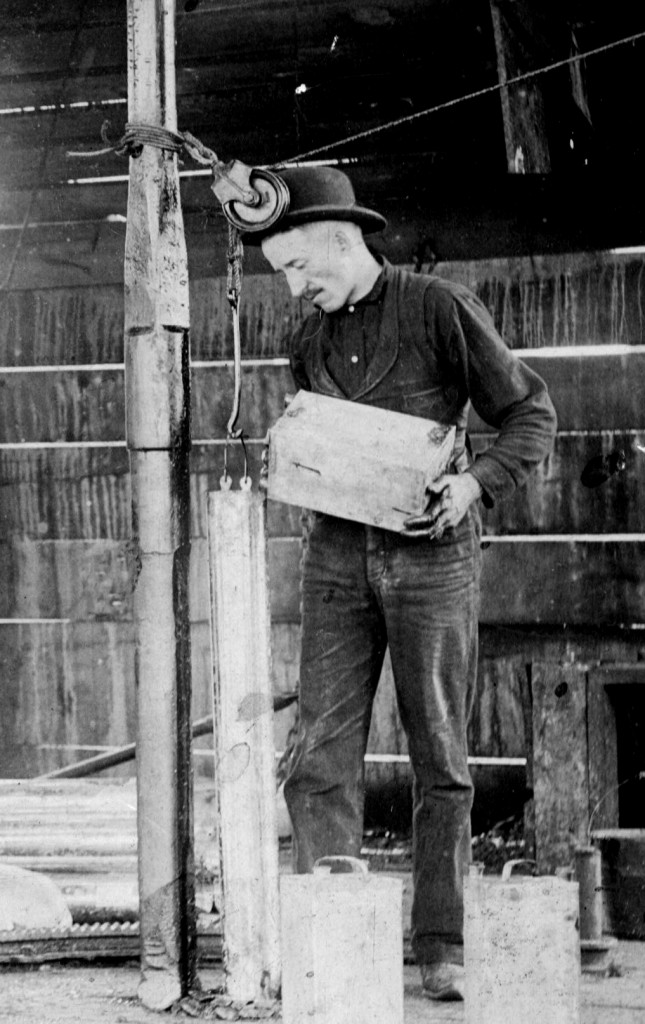
Pouring nitroglycerin was risky enough in late 19th century oilfields. Doing it for an illegal well “shooting” led to the term “moonlighting.”
Roberts died a wealthy man on March 25, 1881, in Titusville. His heirs sold Roberts Petroleum Torpedo Company to its employees, who continued in business as the Independent Explosives Company. By then, the Civil War Union veteran’s revolutionary “fracking” technology was being applied by the petroleum industry worldwide.
Otto Cupler Torpedo Company
Rick Tallini’s historic Otto Cupler Torpedo Company at one time produced its own nitroglycerin in plants near Titusville — until the last of the company’s plants exploded in 1978. They continued using liquid nitroglycerin for more than a decade. Then the company’s final nitroglycerine supplier’s plant exploded in Moosic, Pennsylvania, in 1990.
A century earlier, farther east of the oilfields at Oil City and Titusville (and the notorious boom town of Pithole), the giant Bradford oilfield had its own nitroglycerine manufacturers and fracturing service companies. A notable fracturing operation there was run by an astute business woman (see Mrs. Alford’s Nitro Factory).
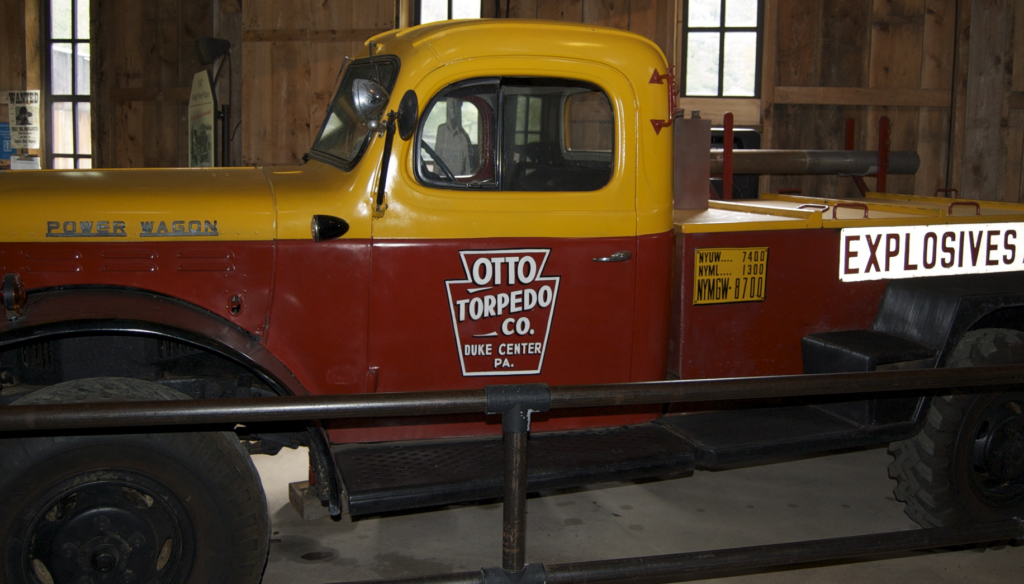
The Drake Well Museum’s 1948 Dodge Power Wagon once hauled hundreds of pounds of liquid nitroglycerin in ten-quart copper cans. The Department of Transportation in 1990 ended the era of hauling liquid nitroglycerin over U.S. roadways. Photo by Bruce Wells.
Tallini’s final well shooting on May 5, 1990, used up the last of his company’s liquid nitro reserves of nitroglycerine. His company would continue shooting wells, but with safer modern explosives and procedures.
The Otto Cupler Company would established a small museum in East Titusville to preserve documents from its earliest “fracking” of wells.
An Otto Cupler Company 1948 Dodge truck was put on display in 2008 at the Drake Well Museum and Park in Titusville. The oil museum’s park has hosted realistic-looking “Nitro Shows” for visitors and school groups.
At the end of the 19th century in Indian Territory, a crowd gathered in Bartlesville to watch a real nitro fracturing of a discovery well. The driller’s young stepdaughter, a Delaware Indian, dropped a “go devil” — the weighted detonating device — down the wire line in well bore to set off the canister of nitroglycerin.
The downhole explosion of April 15, 1897, caused the Nellie Johnstone No.1 well to erupt a geyser of “black gold” that impressed onlookers and launched the Oklahoma petroleum industry (see First Oklahoma Oil Well).
Related to petroleum formation fracturing, development of well perforation was another important downhole oilfield technology.
In 1939, Ira McCullough of Los Angeles received a U.S. patent for his design of a multiple bullet-shot casing perforator, “in which projectiles or perforating elements are shot through the casing and into the formation.”
The innovation of firing at several levels through a borehole’s casing enhanced the flow of oil from geologic formations. Learn more in Downhole Bazooka.
Hydraulic “Fracking”
On March 17, 1949, a team of petroleum production experts converged on an oil well about 12 miles east of Duncan, Oklahoma, to perform the first commercial application of hydraulic fracturing. Later that day, Halliburton and Stanolind company personnel successfully fractured another oil well near Holliday, Texas.

The first commercial hydraulic fracturing of an oil well took place in 1949 about 12 miles east of Duncan, Oklahoma.
A fracking well experiment two years earlier in Hugoton, Kansas — home of a massive natural gas field — had proven the possibility of hydraulic fracturing for increased gas well productivity. Erle Halliburton (1892-1957) had patented an improved method for cementing oil wells in 1921, two years after founding his well service company in Ardmore, Oklahoma.
By 1988, the technology will have been applied nearly one million times. The technique had been developed and patented by Stanolind (later known as Pan American Oil Company) and an exclusive license issued to Halliburton to perform the process. In 1953, the license was extended to all qualified service companies.
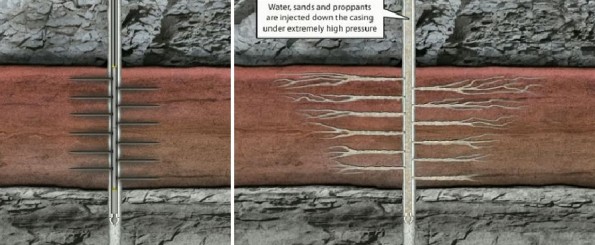
To complete a new well, explosive charges are lowered by a wire line to perforate the steel casing, cement and producing formation. After the charges are electronically fired, hydraulic fracturing greatly enhances oil and natural gas production.
According to a spokesman from Pinnacle, a Halliburton service company:
Since that fateful day in 1949, hydraulic fracturing has done more to increase recoverable reserves than any other technique, and Halliburton has led the industry in developing and applying fracturing technology.
The company representative also noted, “In the more than 60 years following those first treatments, more than two million fracturing treatments have been pumped with no documented case of any treatment polluting an aquifer — not one.”
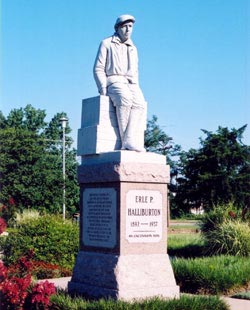
An Erle Halliburton statue was dedicated in 1993 in Duncan, Oklahoma.
Issues concerning water withdrawals for hydraulic fracturing in areas of low availability, spills during the handling of fracturing fluids, and injection of the fluids with inadequate mechanical integrity were among issues raised by the Environmental Protection Agency in its 2016 report, Hydraulic Fracturing For Oil And Gas.
American Shale Revolution
In the 1980s, a sudden technological advance in fracturing shale formations led to the U.S. vastly increasing its oil and especially natural gas production that continues to this day.
Although credit should be shared with others, America’s first “shale boom” began with the innovative thinking from independent producers, especially a Texan from Galveston, George P. Mitchell, (1919 – 2013). Shale fracturing advancements began with steering a well horizontally into producing geological formations.
In the 1980s, Mitchell Energy & Development began experimenting with hydraulic fracturing in horizontal wells in the Barnett Shale near Fort Worth. The company was among the few that began finding ways to extract large amounts of natural gas from shale formations.
On, March 6, 1981, Mitchell Energy drilled its C.W. Slay No. 1 well, the first commercial natural gas well of the Barnett shale formation. Over the next four years, the vertical well produced nearly a billion cubic feet of gas, but it would take almost two decades to perfect cost-effective shale fracturing methods — and combine them with horizontal drilling.
The 7,500-foot-deep Wise County well and others that followed in North Texas helped evaluate seismic and fracturing data to understand deep shale structures.
“The C.W. Slay No. 1 and the subsequent wells drilled into the Barnett formation laid the foundation for the shale revolution, proving that natural gas could be extracted from the dense, black rock thousands of feet underground,” the Dallas Morning News later declared.
More innovations came as geologists recognized the potential of natural gas rich shales in Arkansas (Fayetteville formation) and in Pennsylvania and nearby states (the Marcellus). In the Williston Basin of North Dakota, producing oil since 1951, billions of barrels of new production came from the Bakken shale (see First North Dakota Oil Well).
America’ shale revolution would end the decades of dependence on foreign oil and natural gas supplies.

America’s modern shale boom began in the 1980s when independent producers like George Mitchell experimented with ways to produce natural gas from the Barnett shale in Texas. May 2011 map courtesy Energy Information Administration.
By the end of 2012, with almost 14,000 wells drilled in the Barnett shale — the largest gas field in Texas — production began to decline, but the field still accounted for 6.1 percent of Texas natural gas production, according to the Federal Reserve Bank of Dallas.
Injected Wastewater and Earthquakes
The largest earthquake in Oklahoma known to be induced by a process related to hydraulic fracturing came in 2019, according to the United States Geological Survey. USGS studies confirmed the majority of the state’s earthquakes for the previous decade resulted from injected wastewater methods — not well fracturing fluids.
“Wastewater disposal is a separate process in which fluid waste from oil and gas production is injected deep underground far below ground water or drinking water aquifers,” USGS explained. “In Oklahoma over 90 percent of the wastewater that is injected is a byproduct of oil extraction process and not waste frack fluid.”
In the Permian Basin of West Texas, a major U.S. location of production from shale fields, the Texas Railroad Commission (RRC) in September 2021 reported six earthquakes since February 2020 registered at least a 3.5 magnitude on the Richter scale. The RRC identified the disposal of the large amounts of water used to break apart rock formations as a likely contributor to seismic activity.
The commission, “asked drillers to cut back on the amount of wastewater they’re pumping underground,” according to World Oil. “It’s a fairly unusual move by the regulator, which hasn’t been as active as its counterpart in Oklahoma in trying to prevent earthquakes linked to fracking.”
Petroleum Industry Perspective
Petroleum industry trade groups have established websites to educate a skeptical public about geologic fracturing technologies — “fracking” wells. According to one, “There is no shortage of questions about domestic energy production — what technologies are used? What does it mean for our environment? How does it create jobs? What is hydraulic fracturing, anyway?”
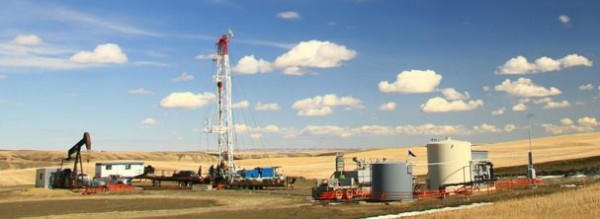
Hydraulic fracturing has been used to increase production on millions of oil and natural gas wells since 1949.
To address public concerns, Energy in Depth — using research from the industry’s long history of well fracturing — has noted: “While the first commercial fracturing job was conducted in the 1940s, the technique has been applied to the vast majority of U.S. oil and natural gas wells to enhance well performance, minimize drilling, and recover otherwise inaccessible resources.”
The Energy In Depth website, a project of the Independent Petroleum Association of America (IPAA), has reported that 90 percent of operating U.S. wells have been fractured, “and the process continues to be applied to boost production in unconventional formations — such as tight gas sands and shale deposits.”
For another perspective about down-hole explosives to increase production, see Project Gasbuggy tests Nuclear “Fracking.”
Roberts at Battle of Fredericksburg
Some Civil War historians might know of Col. Edward A. L. Roberts leading one of the many ill-fated Union charges up Marye’s Heights. Below is American Oil & Gas Historical Society research documenting little-known details from his service records at the National Archives, Washington, D.C.
Oil well “shooting” or “fracking” torpedo inventor Col. Edward A.L. Roberts (1829-1881) was buried in Woodlawn Cemetery at Titusville, Pennsylvania. A simple headstone includes only by his name and the military rank he held at the Battle of Fredericksburg 19 years earlier.
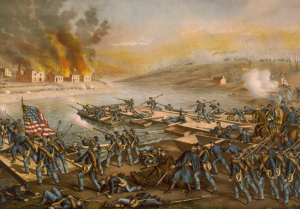
“We went into action under a most galling and deadly fire of shot and shell,” reported Col. Edward Roberts. An 1888 lithograph depicts the Army of the Potomac crossing the Rappahannock at the Battle of Fredericksburg in December 1862. Image courtesy Library of Congess.
For four months during the Civil War, the man who would someday revolutionize oil and natural gas production technology served as Lt. Colonel with the 28th New Jersey Volunteer Infantry Regiment. He fought at Fredericksburg in December 1862 – while awaiting results from his court martial, which had convened just weeks earlier.
As the military court deliberated specifications of “intoxication on dress parade,” Roberts’ regiment marched into the bloody fields and town Fredericksburg, Virginia. On December 13, the 28th New Jersey was the center of Gen. Ambrose Burnside’s first doomed assault on the fiercely defended Marye’s Heights. Fourteen more failed assaults would follow.
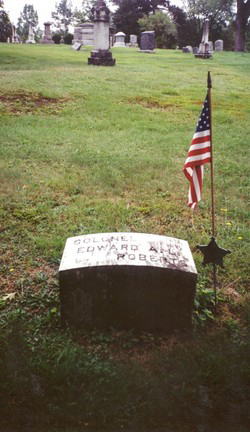
Col. Edward A. L. Roberts is buried in Titusville, Pennsylvania — where the U.S. oil industry began in 1859.
The 28th charged into carefully positioned cannons. Confederate Col. Edward Porter Alexander had declared: “A chicken could not live on that field when we open on it.”
Alexander was right. No Union soldiers would reach Marye’s Heights that cold December day. Crossing a canal and open ground, brigade after brigade could not dislodge the Confederates from their defenses behind a sunken road and stone wall. Union casualties exceeded 12,000.
When his commander was shot in the face during the 28th’s charge, Roberts assumed command. In his after action report, Roberts wrote, “We went into action under a most galling and deadly fire of shot and shell, and continued in action until near dark. Officers and men conducted themselves well.”
A month later, Roberts’ court martial verdict was published under General Order No. 2. Despite his heroic actions during the battle, among the Civil War’s bloodiest, he was found guilty and ordered to be cashiered, effective January 12, 1863. Prior to the court’s verdict, Roberts had attempted to resign, but a superior officer characterized this as “tendering resignation in face of enemy.”
Roberts’ service as a Union officer ended in 1863. He soon would be transforming the Pennsylvania oilfields — and the young U.S. petroleum industry.
Moonlighters shoot Wells
Andrew Dalrymple secretly shot his last well on February 5, 1873, when he and his wife were killed in a nitroglycerin explosion at Dennis Run, Pennsylvania. He allegedly had been “moonlighting” — illegal oil well shooting — in the Tidioute oilfield.

A Pennsylvania historical marker notes the 1865 demonstration of Col. E.A.L. Roberts’ invention.
Nitroglycerine was a powerful but dangerous means of fracturing oil-producing rock formations. The technology had been patented, its use rigorously protected. Pouring nitroglycerin was risky enough in the late 19th century. Doing it illegally at night made it more so.
“The Dalrymple torpedo accident at Tidioute brings to light the fact that nitroglycerine, or other dangerous explosives, are used, stored and manipulated secretly in places little suspected by the general public,” reported the Titusville Morning Herald.
“A large amount of this dangerous material has lately been stolen from the various magazines throughout the country, ” the newspaper added. “This species of theft is winked at by some parties, who are opposed to the Roberts torpedo patent.”
_______________________
Recommended Reading: The Green and the Black: The Complete Story of the Shale Revolution, the Fight over Fracking, and the Future of Energy (2016); The Boom: How Fracking Ignited the American Energy Revolution and Changed the World
(2015); The Frackers: The Outrageous Inside Story of the New Billionaire Wildcatters (2014); The Extraction State, A History of Natural Gas in America (2021). Your Amazon purchase benefits the American Oil & Gas Historical Society. As an Amazon Associate, AOGHS earns a commission from qualifying purchases.
_______________________
The American Oil & Gas Historical Society (AOGHS) preserves U.S. petroleum history. Please become an AOGHS annual supporter and help maintain this energy education website and expand our historical research. For more information, contact bawells@aoghs.org. © 2024 Bruce A. Wells.
Citation Information – Article Title: “Shooters – A “Fracking” History.” Authors: B.A. Wells and K.L. Wells. Website Name: American Oil & Gas Historical Society. URL: https://aoghs.org/technology/hydraulic-fracturing. Last Updated: March 7, 2024. Original Published Date: September 1, 2007.


